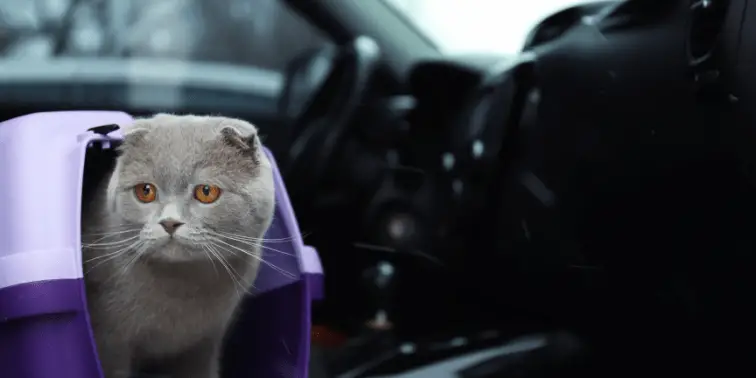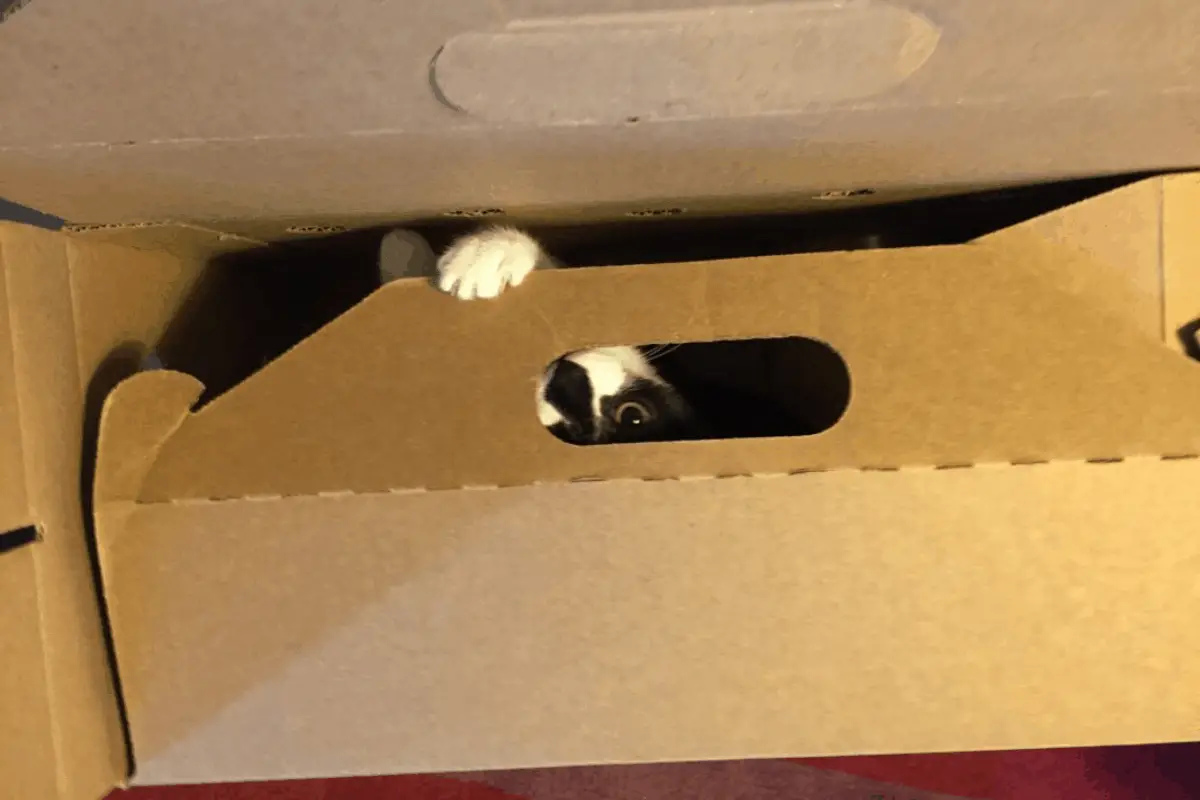Our smart, beautiful calico cat, Paula, found her way to us after being abandoned by college guys in a nearby apartment. Her appearance in our lives was transformative in more ways than we can name. But one thing about this cat that rises to the top is her love of car travel. She shattered all our expectations of traveling, much less moving with cats.
Relocating by car from central Texas to New Hampshire, Paula did not use a carrier while in the car. Instead, she spent her time near the rear windows watching as ranches changed to mountains and rivers. Once out of the car, she even slept comfortably on a friend’s bathroom floor in southeastern Ohio. Paula epitomized the “move-friendly cat”!
However, our beloved Paula was also a rare exception to what you should expect when moving with most cats. Since losing her, we’ve had other cats, and all of them have absolutely despised the car. So if you’re planning to move with cats, keep reading to discover some of the secrets we learned through trial and error.
Table of Contents
Preparing for the Trip
Any move takes weeks, sometimes months of preparation. Getting ready to move with cats can take even longer—unless you start planning early and gradually, that is. Buying disposable litter boxes is simple. Getting necessary veterinary records and filling in forgotten vaccinations are other things entirely. And be 100% sure your cat is flea-free before getting into your car!
Make a List
The list should include:
- Each cat identified by a microchip, collar with ID and rabies tags, and the carrier labeled with the owner’s mobile number and an emergency contact
- All needed supplies for the road
- Food
- Water bottle
- Bowls for food and water
- Cat box, litter, and scoop
- A sturdy carrier with familiar bedding and toys
- A harness and leash
- Sanitizing wipes
- Any medications
- Veterinary records
- Mini-vacuum (for spilled litter, etc.)
- Anything specific to your cat(s)
Prepare Cats With Short Local Trips

Many cats never spend time in cars, except when going to the vet—usually not their favorite experience. So help them get used to authentic travel by driving around town, maybe even stopping to get out of the car while leashed. Short trips should help your cats adjust more quickly to the long moving journey.
Cats in the Car
In her time with us, Paula traveled from Texas to New Hampshire and from NH to SE Wisconsin. Unfortunately, when relocating again to Western New York, our one-year-old kittens, Felix and Georgia, didn’t do so well. They meowed (loudly) in their carriers from our Racine, WI home until we reached the Indiana-Ohio border, where they finally went to sleep.
Sedating Traveling Cats
Years earlier, before departing from NH for WI, we tested a sedative from the vet on Paula. It made her crazed to the point of letting herself flop to the floor from atop moving boxes stacked five feet high (at least she tried to before we stopped her). We didn’t want this to happen with Felix and Georgia. So we skipped the sleepy drugs.
Still, a travel sedative is something to consider in consultation with your vet. A few different sedating medications are available—all-natural ones as well as traditional prescriptions. Give your cats just enough to make them drowsy at the start of each travel day, at least until they get used to the car.
Feeding the Cats
If you don’t want to deal with carsick cats, give them a very small meal a few hours before hitting the road, then nothing more until reaching the day’s destination. If they’re making noise, they might be hungry. But it could be that they don’t feel well and might need some motion sickness medicine too, just like people.
Litter Box
In our experience, cats are unlikely to use a litter box in the car. But they most certainly will need one at the end of the travel day. We recommend the biodegradable disposable kind. Who wants to travel with a used litter box? Still, if you’ve had unpleasant carrier messes in the past, give some thought to a large carrier with a litter box inside. Or try these other solutions.
Lodging
Arriving at the lodging you reserved presents a few more challenges. First, you need to get them out of the car and into the room. Make sure you don’t open any carriers until you’re sure all doors and windows are closed.
One small (but very useful) tip: wherever a cat might be hiding, popping the lid on a can of cat food is extremely likely to draw them out. You can then feed them in the carrier, and let them stay there while you pack and load the car.
Cats in Motels
Long before you begin your moving trip, it’s an excellent idea to look for lodging on your route that accepts pets. Even if they charge a fee, it’s well worth it. Cats are comfortable knowing you’re near, and you won’t need to pick them up, probably already disoriented, before hitting the road again.

Remember to put the cats in their carriers whenever you leave the room. You never know when an employee will stop by with extra supplies or to clean the room. Also, clever cats sometimes can find secret escape routes and wander off. Again, always be sure your cats are both tagged and micro chipped, even while in their carriers.
Cats With No Place to Stay
Most metro areas have some hotels that accept pets. Even so, without a reservation, your arrival might coincide with a major convention, college graduations, holiday travel, and so on. In fact, you might be lucky even to get a room at all, much less one that allows cats! And even if you did make a reservation, oversights on the part of the lodging can happen.
Of course, it’s a lot easier to find an available room without pets. It’s always wise to have a “plan B” for your furry companions. Look for boarding facilities in the area where you’ll stay (being sure to check ratings and reviews) and book space there. Leave a can or bag of their preferred food and some toys or bedding for comfort. Try to arrive as soon as the facility opens.
Another alternative is to alter your route if you have acquaintances in the area who would be willing to help you out. Be sure to send a warm thank you gift afterwards.
Arriving at Your New Home—With Cats
By the time you reach your new home, have completed all the paperwork, and are ready to move in, your cats probably will have begun to feel at home in the car. Now, all of a sudden, they’re home again—only this time, it’s an entirely new and unfamiliar place.
First, remember to keep them in carriers or, better yet, at a boarding facility while your stuff is unloaded at the new place. The last thing you want is for disoriented cats to get in the way or hit the road—maybe even be hit on an unfamiliar road.
Wait until all is settled before letting them explore the new place. Then, expect to see them go into hiding for a while. And, whatever you do, don’t let them outside!
It’s Worth It (Isn’t It?)
Dogs are eager travelers and terrific companions on long trips. Most cats are not. But there are exceptions with both species. As long as most dogs are happy with their humans, they can’t wait to explore new places (and smells). Yet, when cats finally settle into a new home, they assume a sense of ownership and like to watch over things. And they don’t like to leave.
Even humans tend to feel out of sorts when moving to a new home—and we’re not nearly as territorial as cats are. One thing we can say, though, is that having cats, dogs, or both sharing our journey—no matter what their disposition—is one of life’s best rewards. Our pets create memories we will cherish, even long after they’ve left us. So bring them along for the ride!


